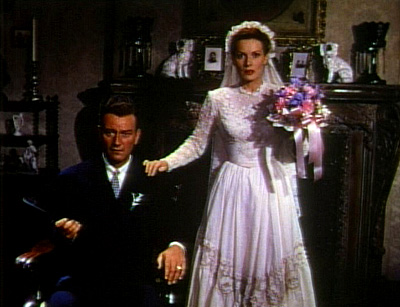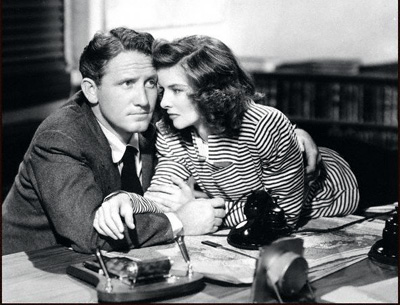
Since it’s St. Patrick’s Day, I thought it would only be proper to devote today’s post to one of the most quintessentially Irish classics, John Ford’s The Quiet Man (1952). While he’s most known for his influential westerns, The Quiet Man is one of my favorite Ford films (along with How Green is My Valley and The Man Who Shot Liberty Valance).
What I love most about it is the love story between Sean Thornton and Mary-Kate Danaher, which are beautifully played by John Wayne and Maureen O’Hara. This would be their second teaming, following immediately on the heels of another Ford classic, Rio Grande (1950). The success of that film is what allowed The Quiet Man to be made. Oddly enough, no studio wanted to touch the film, feeling that it wasn’t commercial enough and therefore, wouldn’t make money (it’s always about money!). John Ford originally bought the short story for ten dollars in 1933, promising the author Maurice Walsh more money if it would ever go into production (according to IMDB, Walsh made a total of $6,260 for The Quiet Man). Finally, Republic, the little studio primarily known for their b-movie westerns, gave The Quiet Man it’s home, but only if Ford made Rio Grande first. Not only was that film successful, but it also teamed Wayne and O’Hara for the first time, a partnership that would last through four more films.
 And it’s their chemistry that makes The Quiet Man such a wonderful film. From the moment Sean spots the beautiful Mary-Kate in a field of sheep, it’s love at first sight. And who can blame him? With her fiery red hair and ivory complexion, Technicolor was made for a woman like Maureen O’Hara. Set against the lush green backdrop, she’s absolutely stunning. Much of the technicolor equipment was shipped in from various London movie studios and a special schedule was set up, so Ford and the rest of his crew would know how long they could film in the summer months. It certainly pays off. The cinematography throughout is gorgeous, especially when the cast travels through the fields, streets and ponds of Ireland. Also adding to the local flavor is the use of the local townspeople in crowd scenes, as well as the casting of many actors from Dublin’s own Abbey Theater.
And it’s their chemistry that makes The Quiet Man such a wonderful film. From the moment Sean spots the beautiful Mary-Kate in a field of sheep, it’s love at first sight. And who can blame him? With her fiery red hair and ivory complexion, Technicolor was made for a woman like Maureen O’Hara. Set against the lush green backdrop, she’s absolutely stunning. Much of the technicolor equipment was shipped in from various London movie studios and a special schedule was set up, so Ford and the rest of his crew would know how long they could film in the summer months. It certainly pays off. The cinematography throughout is gorgeous, especially when the cast travels through the fields, streets and ponds of Ireland. Also adding to the local flavor is the use of the local townspeople in crowd scenes, as well as the casting of many actors from Dublin’s own Abbey Theater.
Part of what makes The Quiet Man stand out from other romance films is the fact that a good portion was shot on location in Ireland–specifically Cong, County Mayo. In the post-WWII era, more and more studios realized that shooting on location was necessary, since backdrops and screens were becoming passe. Ford’s use of Ireland not only adds to the story, but gives it an authenticity. It’s magical to watch Wayne and O’Hara romp through the bright green fields of Ireland and allows the viewer to be transported as well. Instead of watching a movie, you do believe you’re watching two people fall in love. While I have no doubt that The Quiet Man would be wonderful no matter what the backdrop, the fact that it’s taking place in Ireland just makes it that more special.
 As Mary-Kate, O’Hara turns in a wonderful performance. She’s an incredibly complex character–equal parts mystery and passion, with a good wallop of feistyness thrown in. While Mary-Kate is feminine, she’s no shrinking violet either. In their five films, many people say O’Hara was the perfect match for John Wayne’s towering presence and I have to agree. And speaking of John Wayne, this (along with 1943’s A Lady Takes a Chance, with the lovely Jean Arthur) is one of the few films that I find him really sexy in. While masculine, Wayne’s Sean Thornton also displays a vulnerable side, no doubt in part to his tragic boxing past that he keeps hidden from Mary-Kate. He’s head over heels in love with her and pursues her relentlessly. Even though her bullying brother, Red (a terrific performance by Victor McLaglen), refuses to give his sister the dowry she so deserves, Sean could care less, telling her that he’d be happy if she’d “come in the clothes on your back or without them for that matter.”
As Mary-Kate, O’Hara turns in a wonderful performance. She’s an incredibly complex character–equal parts mystery and passion, with a good wallop of feistyness thrown in. While Mary-Kate is feminine, she’s no shrinking violet either. In their five films, many people say O’Hara was the perfect match for John Wayne’s towering presence and I have to agree. And speaking of John Wayne, this (along with 1943’s A Lady Takes a Chance, with the lovely Jean Arthur) is one of the few films that I find him really sexy in. While masculine, Wayne’s Sean Thornton also displays a vulnerable side, no doubt in part to his tragic boxing past that he keeps hidden from Mary-Kate. He’s head over heels in love with her and pursues her relentlessly. Even though her bullying brother, Red (a terrific performance by Victor McLaglen), refuses to give his sister the dowry she so deserves, Sean could care less, telling her that he’d be happy if she’d “come in the clothes on your back or without them for that matter.”
But it’s that dowry that leads to The Quiet Man‘s final showdowns. First with Mary-Kate, where much to the amusement of the local townspeople, Sean drags her kicking and screaming across the Irish countryside in an attempt to show her just how much he cares about her. In one of my favorite scenes, Sean finally gets Mary-Kate her dowry, only to throw it away in a threshing machine. It’s such a fantastic moment on so many levels: the fact that Mary-Kate is finally free of the money burden as well as her newfound admiration for her husband. With a triumphant look and eyes filled with love, Mary-Kate turns away and announces that she’s going to go home and make his supper. This, of course, leads to the climatic and hilarious fist fight. To describe it here would do it no justice–it’s something you really have to see to believe.
 Since I’m not that knowledgeable about John Ford, I’ll refrain from delving any deeper into The Quiet Man. But I will say that it’s one of the finest love stories I’ve ever watched. Not only is the story rich with characterizations, but it’s also filled with fine performances from Ford regulars like Barry Fitzgerald, Ward Bond and Mildred Natwick, as well as Ford’s own brother Francis. And while The Quiet Man may be the perfect film to watch on St. Patrick’s Day, it’s also perfect for any time when you’re in the mood for a top-notch love story that’s not too sappy. It’s what you could call, a perfect film.
Since I’m not that knowledgeable about John Ford, I’ll refrain from delving any deeper into The Quiet Man. But I will say that it’s one of the finest love stories I’ve ever watched. Not only is the story rich with characterizations, but it’s also filled with fine performances from Ford regulars like Barry Fitzgerald, Ward Bond and Mildred Natwick, as well as Ford’s own brother Francis. And while The Quiet Man may be the perfect film to watch on St. Patrick’s Day, it’s also perfect for any time when you’re in the mood for a top-notch love story that’s not too sappy. It’s what you could call, a perfect film.
Links: Here’s a site detailing tours and a museum devoted to The Quiet Man, while a fan recounts his love of the film, as well as his trip to Ireland.
Also, since it’s St. Patrick’s Day, the mothering instinct in me would like to tell you that if you go out drinking tonight, please, please, please do it safely. And since I stopped drinking about two years ago, have a green beer for me. I am currently cooking a huge pot of corned beef, cabbage and potatoes and since my mother only taught me how to cook in huge quantities, I have enough food to feed a small army. If it were possible, I’d invite anyone reading this to come on over and have a plate–there’s even enough for seconds and thirds!









